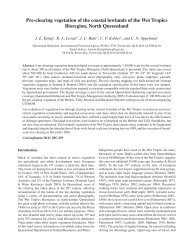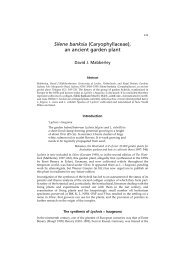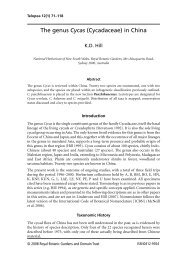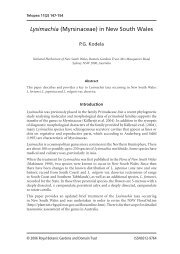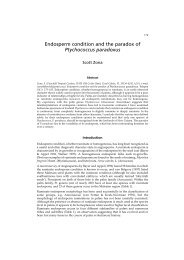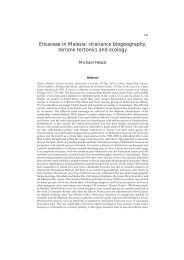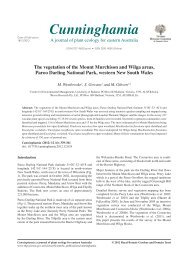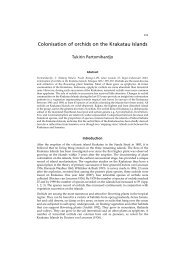Bryophytes and their distribution in the Blue Mountains region of ...
Bryophytes and their distribution in the Blue Mountains region of ...
Bryophytes and their distribution in the Blue Mountains region of ...
You also want an ePaper? Increase the reach of your titles
YUMPU automatically turns print PDFs into web optimized ePapers that Google loves.
Cunn<strong>in</strong>ghamia 10(2): 2007 Down<strong>in</strong>g et al, <strong>Bryophytes</strong> <strong>in</strong> <strong>the</strong> <strong>Blue</strong> Mounta<strong>in</strong>s 253<br />
<strong>Bryophytes</strong> are abundant <strong>in</strong> deep shade <strong>of</strong> closed forests, <strong>and</strong><br />
<strong>in</strong>clude dendroid bryophytes, such as <strong>the</strong> moss Hypnodendron<br />
vitiense subsp. australe <strong>and</strong> <strong>the</strong> liverwort Hymenophyton<br />
flabellatum, <strong>the</strong> liverwort-like moss Achrophyllum dentatum<br />
<strong>and</strong> thallose liverworts such as Podomitrium phyllanthus,<br />
Pallavic<strong>in</strong>ia spp. <strong>and</strong> Symphyogyna spp. The road from<br />
Mount Wilson to Mount Irv<strong>in</strong>e is cut through closed forest<br />
provid<strong>in</strong>g an ‘edge’ that is open to <strong>the</strong> light, thus support<strong>in</strong>g<br />
an assemblage <strong>of</strong> bryophytes that normally grow on <strong>the</strong><br />
marg<strong>in</strong>s <strong>of</strong> closed forests such as <strong>the</strong> epiphytes Macrocoma<br />
tenuis, Macromitrium spp., Papillaria spp. <strong>and</strong> Frullania<br />
spp. Epiphytes are abundant on ornamental street trees.<br />
Bryophyte taxa that are uncommon <strong>in</strong> <strong>the</strong> <strong>Blue</strong> Mounta<strong>in</strong>s,<br />
<strong>in</strong>clud<strong>in</strong>g Asterella drummondii, Plagiochasma rupestre,<br />
Reboulia hemisphaerica <strong>and</strong> Solenostoma <strong>in</strong>undatum grow<br />
on basalt-derived soils on steep, roadside banks. The thallose<br />
liverwort *Lunularia cruciata occurs here with capsules, rare<br />
<strong>in</strong> <strong>the</strong> <strong>Blue</strong> Mounta<strong>in</strong>s. Colonis<strong>in</strong>g species such as Dawsonia<br />
superba var. pulchra, Pogonatum neesii <strong>and</strong> Pogonatum<br />
subulatum are common on l<strong>and</strong>slips (Figure 12). Roadsides<br />
are commonly covered with Rosulabryum billarderi <strong>and</strong><br />
cPolytrichum juniper<strong>in</strong>um. Mount Wilson is one <strong>of</strong> <strong>the</strong> few<br />
locations where hornworts are a conspicuous component <strong>of</strong><br />
<strong>the</strong> bry<strong>of</strong>lora.<br />
Lawson is lower <strong>in</strong> altitude than Blackheath, Wentworth Falls<br />
or Mount Wilson, <strong>and</strong> has a correspond<strong>in</strong>gly lower ra<strong>in</strong>fall.<br />
Although <strong>the</strong> gullies are not as deep or dramatic as those <strong>of</strong><br />
<strong>the</strong> upper <strong>Blue</strong> Mounta<strong>in</strong>s, <strong>the</strong>re is a big range <strong>of</strong> habitats<br />
with creeks, waterfalls <strong>and</strong> gullies associated with swamps,<br />
heath, woodl<strong>and</strong>, open <strong>and</strong> closed forest, all with<strong>in</strong> close<br />
walk<strong>in</strong>g distance <strong>of</strong> <strong>the</strong> railway station <strong>and</strong> ma<strong>in</strong> highway.<br />
Accessibility has probably been a major factor <strong>in</strong> <strong>the</strong> size<br />
<strong>of</strong> <strong>the</strong> collections from this area, with many well-developed<br />
walk<strong>in</strong>g tracks on both <strong>the</strong> nor<strong>the</strong>rn <strong>and</strong> sou<strong>the</strong>rn side <strong>of</strong> <strong>the</strong><br />
railway station.<br />
Conclusion<br />
This study presents species lists <strong>of</strong> mosses, liverworts <strong>and</strong><br />
hornworts recorded from, <strong>and</strong> provides <strong>in</strong>formation on<br />
<strong><strong>the</strong>ir</strong> <strong>distribution</strong> with<strong>in</strong> <strong>the</strong> <strong>Blue</strong> Mounta<strong>in</strong>s <strong>region</strong> <strong>of</strong> New<br />
South Wales. The species lists <strong>in</strong>clude collections from<br />
both bushl<strong>and</strong> <strong>and</strong> urban areas. The locations with <strong>the</strong> most<br />
species are <strong>in</strong> <strong>the</strong> upper <strong>Blue</strong> Mounta<strong>in</strong>s, where diversity is<br />
likely to result from a comb<strong>in</strong>ation <strong>of</strong> altitude, ra<strong>in</strong>fall, range<br />
<strong>of</strong> topographic features <strong>and</strong> accessibility. The species lists<br />
<strong>in</strong>clude many records from areas, such as Wollemi National<br />
Park, Gardens <strong>of</strong> Stone National Park, Newnes Plateau <strong>and</strong><br />
Kanangra-Boyd National Park that were not accessible to <strong>the</strong><br />
early collectors <strong>of</strong> <strong>the</strong> late 19 th <strong>and</strong> early 20 th centuries. Future<br />
collect<strong>in</strong>g <strong>in</strong> areas that at present are poorly represented,<br />
such as Glenbrook, Spr<strong>in</strong>gwood, Wheeney Creek, Kanangra-<br />
Boyd National Park <strong>and</strong> <strong>the</strong> canyons fr<strong>in</strong>g<strong>in</strong>g Newnes plateau<br />
should result <strong>in</strong> significantly <strong>in</strong>creased species numbers for<br />
those areas.<br />
Acknowledgements<br />
Helen Ramsay has supported this project from <strong>the</strong> outset <strong>and</strong><br />
her encouragement <strong>and</strong> <strong>in</strong>terest have been <strong>in</strong>valuable. We are<br />
most appreciative <strong>of</strong> assistance from The National Herbarium<br />
<strong>of</strong> New South Wales, from Joseph<strong>in</strong>e Milne <strong>and</strong> Niels<br />
Klazenga from The National Herbarium <strong>of</strong> Victoria, Christ<strong>in</strong>e<br />
Cargill, Judith Curnow <strong>and</strong> He<strong>in</strong>o Lepp from The Australian<br />
National Herbarium <strong>in</strong> Canberra <strong>and</strong> Murray Henwood from<br />
The John Ray Herbarium at University <strong>of</strong> Sydney. We are<br />
<strong>in</strong>debted to participants <strong>in</strong> <strong>the</strong> 2001 Australasian Bryological<br />
Workshop <strong>in</strong> <strong>the</strong> <strong>Blue</strong> Mounta<strong>in</strong>s: Jan Allan, Karen<br />
Beckman, Jessica Beever, Graham Bell, Volker Buchbender,<br />
Christ<strong>in</strong>e Cargill, Kerri Clarke, Wil Cuddy, Judith Curnow,<br />
Paddy Dalton, Allan Fife, Aaron Floyed, Reijel Gard<strong>in</strong>er,<br />
Scott Gilmore, Helen Jolley, Niels Klazenga, He<strong>in</strong>o Lepp,<br />
Hannah McPherson, Joseph<strong>in</strong>e Milne, Perpetua Turner <strong>and</strong><br />
Joy Williams. We thank New South Wales National Parks<br />
<strong>and</strong> Wildlife Service for permission to work <strong>in</strong> <strong>the</strong> various<br />
national parks <strong>of</strong> <strong>the</strong> <strong>Blue</strong> Mounta<strong>in</strong>s, <strong>Blue</strong> Mounta<strong>in</strong>s City<br />
Council for permission to work <strong>in</strong> council reserves <strong>and</strong><br />
Macquarie University for provid<strong>in</strong>g laboratory facilities.<br />
Figures 1, 2 <strong>and</strong> 3 were prepared by Dean Oliver.<br />
References:<br />
Adam, P. (1994) Australian Ra<strong>in</strong>forests. (Oxford University Press:<br />
Oxford).<br />
Beever, J., Allison, K.W. & Child, J. (1992) The mosses <strong>of</strong> New<br />
Zeal<strong>and</strong>. (University <strong>of</strong> Otago Press: Duned<strong>in</strong>).<br />
Branagan, D.F. & Packham, G.H. (2000) Field geology <strong>of</strong> New<br />
South Wales. (Department <strong>of</strong> M<strong>in</strong>eral Resources, New South<br />
Wales, Sydney, Australia).<br />
Buck, W.R., Vitt, D.H. & Malcolm, W.M. (2002) Key to <strong>the</strong><br />
genera <strong>of</strong> Australian mosses. Flora <strong>of</strong> Australia Supplementary<br />
Series Number 14, (Australian Biological Resources Study:<br />
Canberra).<br />
Burges, A. (1932) Notes on <strong>the</strong> mosses <strong>of</strong> New South Wales<br />
1. Additional records <strong>and</strong> description <strong>of</strong> a new species <strong>of</strong><br />
Buxbaumia. Proceed<strong>in</strong>gs <strong>of</strong> <strong>the</strong> L<strong>in</strong>nean Society <strong>of</strong> New South<br />
Wales. 57: 239–244.<br />
Burges, A. (1935) Notes on <strong>the</strong> mosses <strong>of</strong> New South Wales 11.<br />
Additional records. Proceed<strong>in</strong>gs <strong>of</strong> <strong>the</strong> L<strong>in</strong>nean Society <strong>of</strong> New<br />
South Wales. 60: 83–93.<br />
Burke, A. (1988) Awesome Cliffs, Fairy Dells <strong>and</strong> Lovers<br />
Silhouetted <strong>in</strong> <strong>the</strong> Sunset. A Recreational History <strong>of</strong> <strong>the</strong> <strong>Blue</strong><br />
Mounta<strong>in</strong>s, 1870 – 1939. pp. 99–117 In Stanbury, P. (Ed.)<br />
The <strong>Blue</strong> Mounta<strong>in</strong>s – Gr<strong>and</strong> adventure for all. The Macleay<br />
Museum (Second Back Row Press: Leura, NSW).<br />
Catcheside, D.G. (1980) Mosses <strong>of</strong> South Australia. (Government<br />
Pr<strong>in</strong>ter: South Australia).<br />
Commonwealth Bureau <strong>of</strong> Meteorology (2006) Climatic averages<br />
for Australian sites. http://www.bom.gov.au/climate/averages/<br />
accessed 22.iii.2006.<br />
Department <strong>of</strong> Environment <strong>and</strong> Heritage (2003) http://www.<br />
deh.gov.au/heritage/awh/worldheritage/sites/blue/ accessed<br />
November, 2003.<br />
Down<strong>in</strong>g, A.J. (1992) Distribution <strong>of</strong> bryophytes on limestones <strong>in</strong><br />
Eastern Australia. The Bryologist 95(1): 5–14.





